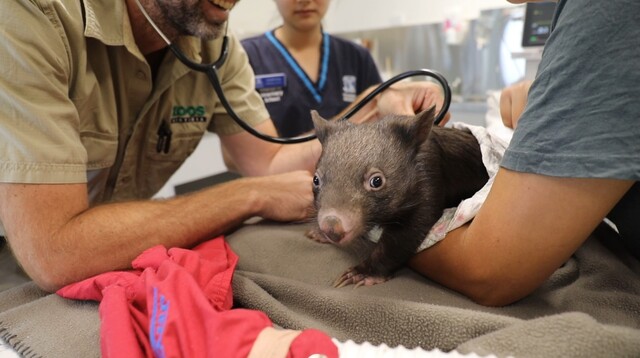Two orphaned joeys have defied the odds and will eventually return to the wild following lifesaving care at Werribee Open Range Zoo.
The four-month-old common wombat and seven-month-old eastern grey kangaroo were each found debilitated by the side of a road next to their mothers who had died from road trauma injuries.
The Australian natives were each taken to wildlife carers who sought expert medical support from the team at Werribee Open Range Zoo’s RSPCA Koala Ward.
Veterinarian Dr Jen O’Dwyer said the juvenile wombat weighed just 380 grams and the kangaroo joey only 1.2 kilograms when they were first brought in for specialist treatment. The wombat, who has been affectionately named Myrtle, arrived from the Central Highlands district, while the kangaroo named Ruth was found in Bylands.
“Both joeys were found to be highly dehydrated upon arrival as they had not had access to their mother’s milk – an important source of energy, calcium and protein to support growth during early life development,” Dr O’Dwyer said.
Each was provided with round-the-clock feeds of specialised milk, supplementary electrolytes and oral rehydration therapy. The joeys underwent thorough examinations under anaesthesia, which included blood tests, X-rays and ultrasounds. Kangaroo Ruth was treated for forearm abrasions, and wombat Myrtle was treated for pneumonia. Both were provided with pain relief and colic medication to relieve trapped gas in their digestive system, which can occur because of stress and diet.
“They’ve had a tough start to life, but with plenty of care from zoo vets, nurses and their wildlife carers, both joeys are now starting to thrive,” Dr O’Dwyer said.
“Myrtle, in particular, has grown and now weighs approximately three kilograms.”
Ruth was an inpatient at Werribee Open Range Zoo for three days in January and had a return check-up in February.
Myrtle had three separate visits throughout January and February to support her ongoing care.
“When we have cases like Ruth and Myrtle, where we can see them through their medical care and then on to being rehabilitated by carers, there is no better feeling,” Dr O’Dwyer said. “Health permitting, once they are old enough to fend for themselves in the coming months, they will be released back into the wild in a safe location nearby where they were originally found.”
Dr O’Dwyer said wildlife road trauma injuries are sadly common, however there are some simple steps to help reduce impacts to wildlife during road travel.
“Pay attention to road signage and try to avoid travelling during dawn and dusk as that is when animals are generally more active. If you need to travel during that time, be alert and aware at all times. If you come across an animal that is injured or distress, please contact Wildlife Victoria or your local wildlife carer who will be able to provide expert advice about the best course of action to take.”








